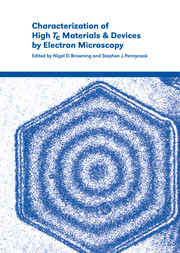Book contents
- Frontmatter
- Contents
- List of contributors
- Preface
- 1 High-resolution transmission electron microscopy
- 2 Holography in the transmission electron microscope
- 3 Microanalysis by scanning transmission electron microscopy
- 4 Specimen preparation for transmission electron microscopy
- 5 Low-temperature scanning electron microscopy
- 6 Scanning tunneling microscopy
- 7 Identification of new superconducting compounds by electron microscopy
- 8 Valence band electron energy loss spectroscopy (EELS) of oxide superconductors
- 9 Investigation of charge distribution in Bi2Sr2CaCu2O8 and YBa2Cu3O7
- 10 Grain boundaries in high Tc materials: transport properties and structure
- 11 The atomic structure and carrier concentration at grain boundaries in YBa2Cu3O7–δ
- 12 Microstructures in superconducting YBa2Cu3O7 thin films
- 13 Investigations on the microstructure of YBa2Cu3O7 thin-film edge Josephson junctions by high-resolution electron microscopy
- 14 Controlling the structure and properties of high Tc thin-film devices
1 - High-resolution transmission electron microscopy
Published online by Cambridge University Press: 21 August 2009
- Frontmatter
- Contents
- List of contributors
- Preface
- 1 High-resolution transmission electron microscopy
- 2 Holography in the transmission electron microscope
- 3 Microanalysis by scanning transmission electron microscopy
- 4 Specimen preparation for transmission electron microscopy
- 5 Low-temperature scanning electron microscopy
- 6 Scanning tunneling microscopy
- 7 Identification of new superconducting compounds by electron microscopy
- 8 Valence band electron energy loss spectroscopy (EELS) of oxide superconductors
- 9 Investigation of charge distribution in Bi2Sr2CaCu2O8 and YBa2Cu3O7
- 10 Grain boundaries in high Tc materials: transport properties and structure
- 11 The atomic structure and carrier concentration at grain boundaries in YBa2Cu3O7–δ
- 12 Microstructures in superconducting YBa2Cu3O7 thin films
- 13 Investigations on the microstructure of YBa2Cu3O7 thin-film edge Josephson junctions by high-resolution electron microscopy
- 14 Controlling the structure and properties of high Tc thin-film devices
Summary
Introduction
High-resolution transmission electron microscopy (HRTEM) has been widely and effectively used for analyzing crystal structures and lattice imperfections in various kinds of advanced materials on an atomic scale. This is especially the case for high Tc superconductors (HTSCs). The most characteristic feature in crystal structures of HTSCs is that there is a common structural element, a CuO2 plane, in which superconductive carriers (positive holes or electrons) are transported. The remaining part, sandwiching the CuO2 planes, accommodates additional oxygen atoms or lattice defects to provide carriers to the CuO2 planes. This is known as the charge reservoir. The transition temperature between superconductive and non-superconductive states, Tc, strongly depends on the concentration of carriers in CuO2 planes and the number of CuO2 planes. Any charge reservoir is composed of some structural elements, including lattice defects. An aim of HRTEM is to clarify the structure of the charge reservoirs. Additionally, a variety of microstructures strongly affect the critical current density, Jc, since they closely relate to the weak link at boundaries between superconductive grains as well as to the pinning of magnetic fluxoids. The characterization of point defects, dislocations, stacking faults, precipitates, grain boundaries, interfaces and surface structures is another important aim of HRTEM. In this chapter, we describe some fundamental issues in analyzing crystal structures and microstructures in HTSCs by HRTEM.
Theoretical background for HRTEM
HRTEM images closely depend not only on some optical factors in the imaging process by the electron lens, but also on a scattering process of the electrons incident on the crystal specimen [1.1]. This section describes the electron-optical background for HRTEM.
- Type
- Chapter
- Information
- Publisher: Cambridge University PressPrint publication year: 2000

